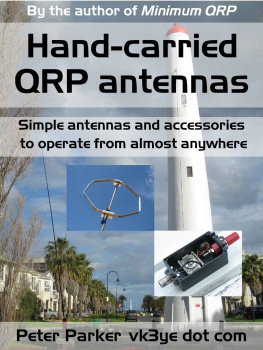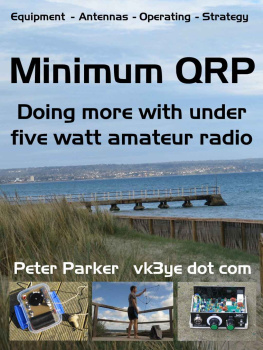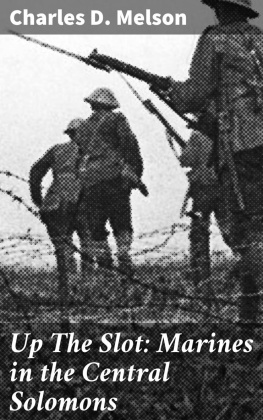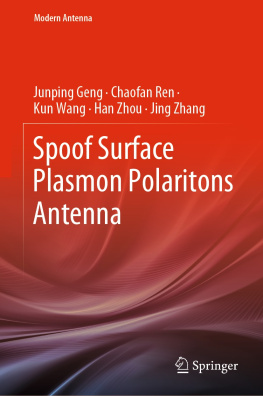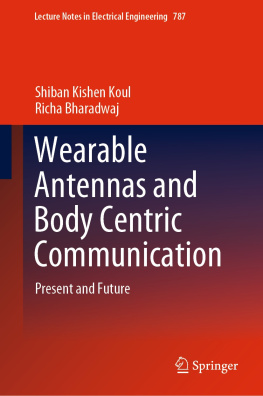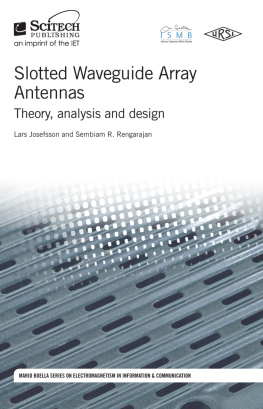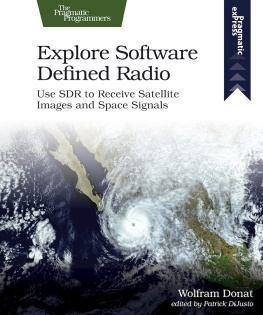John Portune W6NBC - Slot Antennas for Ham Radio: The Forgotten Antenna
Here you can read online John Portune W6NBC - Slot Antennas for Ham Radio: The Forgotten Antenna full text of the book (entire story) in english for free. Download pdf and epub, get meaning, cover and reviews about this ebook. year: 2020, genre: Children. Description of the work, (preface) as well as reviews are available. Best literature library LitArk.com created for fans of good reading and offers a wide selection of genres:
Romance novel
Science fiction
Adventure
Detective
Science
History
Home and family
Prose
Art
Politics
Computer
Non-fiction
Religion
Business
Children
Humor
Choose a favorite category and find really read worthwhile books. Enjoy immersion in the world of imagination, feel the emotions of the characters or learn something new for yourself, make an fascinating discovery.
- Book:Slot Antennas for Ham Radio: The Forgotten Antenna
- Author:
- Genre:
- Year:2020
- Rating:3 / 5
- Favourites:Add to favourites
- Your mark:
- 60
- 1
- 2
- 3
- 4
- 5
Slot Antennas for Ham Radio: The Forgotten Antenna: summary, description and annotation
We offer to read an annotation, description, summary or preface (depends on what the author of the book "Slot Antennas for Ham Radio: The Forgotten Antenna" wrote himself). If you haven't found the necessary information about the book — write in the comments, we will try to find it.
Slot Antennas for Ham Radio: The Forgotten Antenna — read online for free the complete book (whole text) full work
Below is the text of the book, divided by pages. System saving the place of the last page read, allows you to conveniently read the book "Slot Antennas for Ham Radio: The Forgotten Antenna" online for free, without having to search again every time where you left off. Put a bookmark, and you can go to the page where you finished reading at any time.
Font size:
Interval:
Bookmark:
Slot Antennas for Ham Radio
The Forgotten Antenna
John Portune W6NBC
W6NBC Publications

Copyright 2020 John Portune W6NBC
All rights reserved
No part of this book may be reproduced, or stored in a retrieval system, or transmitted in any form or by any means, electronic, mechanical, photocopying, recording, or otherwise, without express written permission of the publisher.
ISBN-13: 9781234567890
ISBN-10: 1477123456
Cover design by: Art Painter
Library of Congress Control Number: 2018675309
Printed in the United States of America
For Rebecca KF6OEB, my lovely wife, whose encouragement, conceptual and editorial assistance permeates this book. We both take deep satisfactiion in helping to awaken the creativity in others who also enjoy our hobby.
Contents
ABOUT THE AUTHOR
John Portune W6NBC

I may be reached at: and w6nbc.com
Native of Los Angeles, CA.
Licensed 1965, Extra 1972. Commercial, GROL, General Radio Telegraph.
Bachelors degree in Physics, Oregon State University 1960.
Career (Retired) TV broadcast television engineer/instructor, KNBC Ch 4 Burbank, CA, Sony Broadcast, San Francisco.
Radio license testing team leader. Ham License in One Day quarterly seminars, VE Laurel VEC, CE National Radio Examiners (Commercial).
Published magazine author: QST (frequently), World Radio, 73 and others.
QST Cover Plaque Awards.
First Place (VHF) 2017 QST Antenna Design Competition.
QST Cover Oct. 2019
Active on HF, VHF and UHF SSB, AM, FM, and digital modes. AMSAT satellite user.
Frequent speaker at ham radio clubs and conventions. Past President, Satellite ARC, Vandenberg AFB.
Free remote teleconference presentations for club meetings (see w6nbc.com).
1: Re-Discovering the Slot Antenna
T his book is a voyage of discovery, or more correctly a voyage of re-discovery. The story begins in the magic age of radio when most commercial and ham radio antennas that we use today were just being developedthe 1930s. Radio engineers knew of the slot antenna then, but not until 1938 did its considerable benefits come to the full attention of the radio world. Alan Blumlein, at EMI in England, demonstrated to the infant television industry that a vertical slot antenna was exactly what TV broadcasters needed to be able to reach out in all directions with TV signals.

Figure 1-1: Alan Blumlein, EMI UK
A TV broadcasting antenna must be omni-directional like a vertical dipole. to be able to reach out to TV viewers in all directions. However, unlike a vertical dipole, it must also be horizontally polarized. The reason? Horizontal polarization had been adopted as the accepted standard for TV broadcasting by then. Ill explain why later, and its is a critical part of the story.
Because of Blumleins recommendation, TV transmitting towers around the world soon bristled with slot antennas; many still do. Slots today find widespread use in microwaves, cell phones and computer applications. Hams, however, have never shown much interest, even though there is considerable potential for practical HF, VHF and UHF ham radio slot antennas. Still, to see why the slot antenna never became popular in amateur radio, let me take you on the first steps of your journey of re-discovery with a review of some essential highlights from the early days of radio and television. Understanding the slot antenna and to make it practical for ham radio relies, to a very great degree, on these insights from yesteryear.
Objectives of This Book
. To suggest why hams may have overlooked slot antennas.
. To clear up the aura of mystery that surrounds how an opening, a hole, a slot in a metal sheet can act as an antenna,
. To develop intuitive rules of thumb for building ham slot antennas.
To present a sampling of practical home-brew ham radio slot antennas, including designs for the HF bands.
I built every one of the antennas in this book on my own journey of re-discovery. If you do the same for even some, you too will understand why the slot antenna is not mysterious and that it has many excellent applications in ham radio.
Why was the Slot Overlooked?
In todays ham radio world, the most common antennas are dipoles, yagis, inverted Vs, quads, log periodics and discones, to name just a few. If slots are ever mentioned, they are a long way down the list. Ill explore why in this chapter. These are the first steps in your journey of re-discovery.
The slot antenna entered the radio world in 1938 as a VHF antenna. VHF is important. Why? Simply because hamming at VHF, the frequencies above 30 MHz, was not yet common back then. Few hams in 1938 would have believed that by the early 21 st Century, 2 meters (VHF) would be the most popular ham radio band.
Historically, hamming had begun at low frequency. Marconi, Lodge and Tesla thought in terms of long waveshundreds of meters. LF was king then. Marconi later admitted that had he not been so focused on long waves and had instead used short waves, he might have succeeded with his famous Transatlantic transmission earlier than 1901. Still, even by 1938, ham activity remained almost exclusively on 80m, 40m, and 20m short wave.
Even the short wave ham bands had only been assigned barely a decade earlier in 1924. Before then, radio had all been lower. The ham 5m VHF band (60 MHz) did exist then, on paper, but was little used. Only more experienced hams then ventured above 30 MHz. Radio handbooks of Blumlein's day often placed 5m projects in a special antennas chapter. Hams did not even begin using 10 meters until the FCC assigned it three year later in 1927.
VHF really first appears in 1938 at the Cairo Conference. In the same year the slot was introduced, the 2 meter (112 Mc) and the 1 meter (224 Mc) ham band were allocated. For hams, VHF was the new kid on the block. The 2-meter band of today was not available to amateurs until 1945, right after WWII. No hamming was allowed during the war.
Even then, not until the 1950s did VHF projects begin to regularly appear in ham radio magazines and handbooks. Vacuum tubes still reigned supreme and only a few worked well at VHF frequencies. The first transistor was not invented until 1947 by American physicists John Bardeen and Walter Brattain while working under William Shockley at Bell Labs . Power transistors for VHF, the primary component of todays modern 2m transceiver, were still years away in the future.
It is little wonder then that a VHF antenna failed to catch the eye of amateur radio operators in 1938. Long wires, dipoles and early HF Yagi beams were the hot tickets. A VHF slot antenna had little appeal. Only commercial television broadcasters had begun making use of the slot. They also found a handful of HF applications on in aviation. H ams then largely ignored slot antennas.
Moving Higher in Frequency
F inally, by the time hams did begin to show an interest in VHF, the commercial radio world had largely forgotten about slot antennas for lower frequencies. Their focus had shifted upward to microwave and to radar applications, Figure 1-2. Hence slot antennas, on the frequencies that hams were using then, were now being

Font size:
Interval:
Bookmark:
Similar books «Slot Antennas for Ham Radio: The Forgotten Antenna»
Look at similar books to Slot Antennas for Ham Radio: The Forgotten Antenna. We have selected literature similar in name and meaning in the hope of providing readers with more options to find new, interesting, not yet read works.
Discussion, reviews of the book Slot Antennas for Ham Radio: The Forgotten Antenna and just readers' own opinions. Leave your comments, write what you think about the work, its meaning or the main characters. Specify what exactly you liked and what you didn't like, and why you think so.



